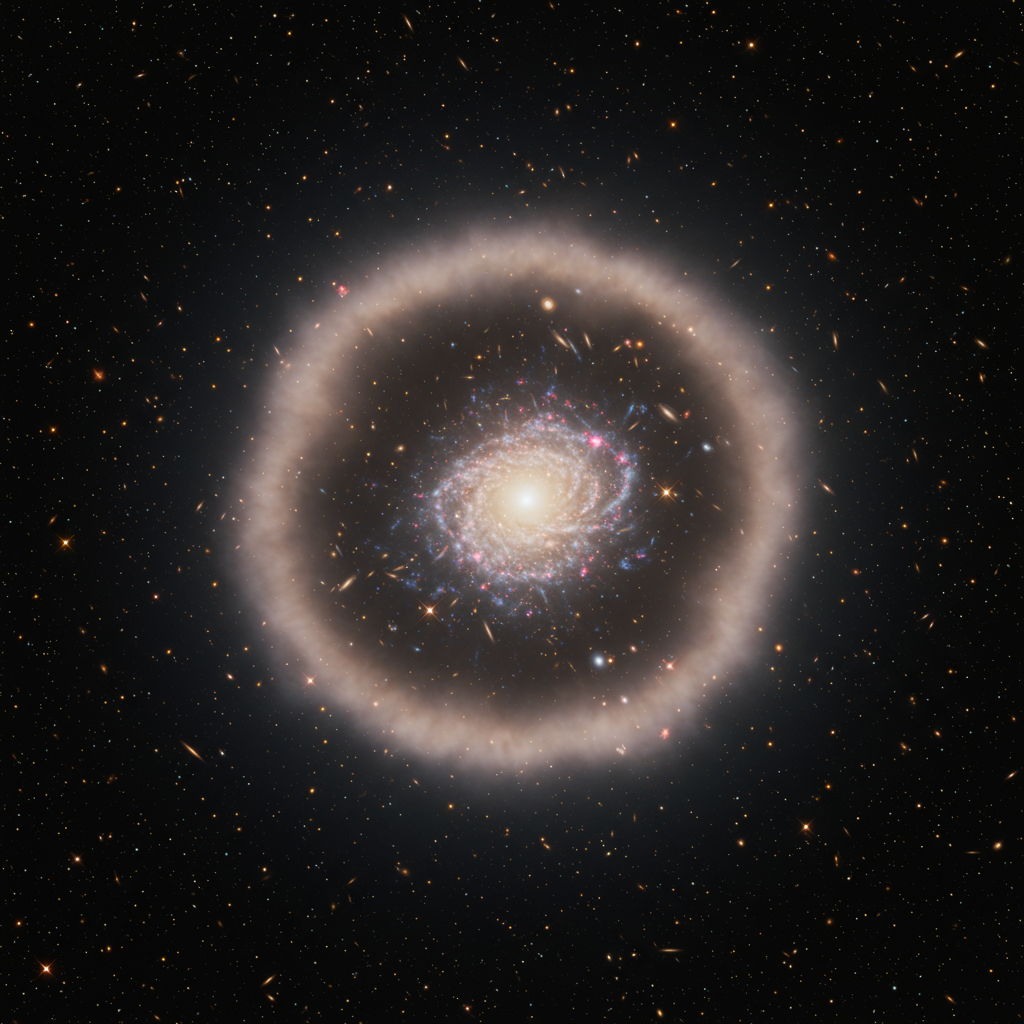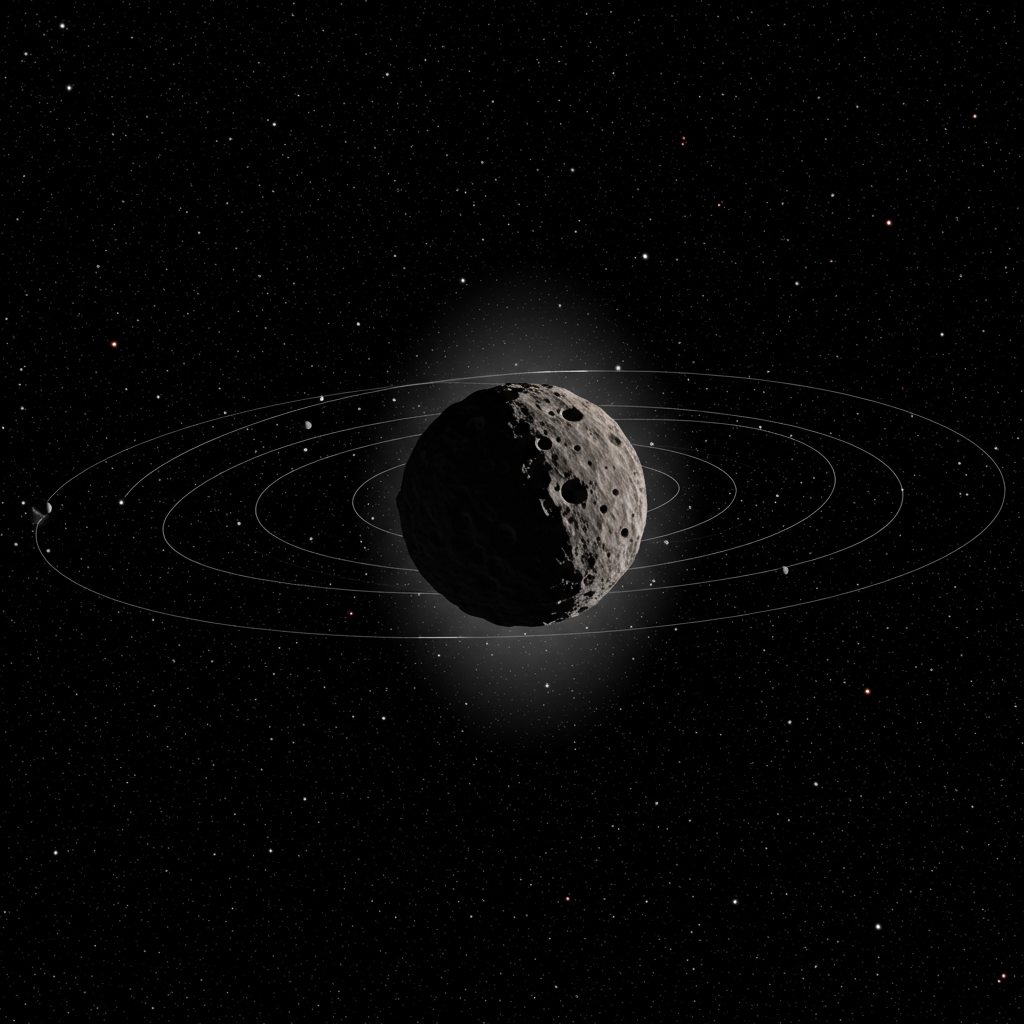Imagine peering 10 billion years into the past. This is precisely what astronomers achieved recently with a groundbreaking discovery that is challenging our understanding of the early cosmos. Scientists have detected the most distant “mini-halo” ever observed – a colossal cloud of energetic charged particles surrounding a remote galaxy cluster. This finding, located at an astonishing distance that reveals the universe as it was in its infancy, offers surprising clues about the powerful processes that shaped cosmic structures billions of years ago. The unexpected nature of this ancient mini-halo suggests the early universe was far more energetic than previously thought, potentially rewriting key chapters in the story of galaxy formation and evolution.
The discovery was made while analyzing a radio signal originating from the galaxy cluster SpARCS1049, situated approximately 10 billion light-years away. Light, even the fastest thing we know, takes time to travel across the vastness of space. Therefore, observing objects billions of light-years away is essentially looking back in time. Just as sunlight takes about eight minutes to reach Earth, showing us the Sun as it was minutes ago, light from objects 10 billion light-years away shows us the universe as it existed 10 billion years ago. Telescopes like the Low Frequency Array (LOFAR), which detected this mini-halo, act like cosmic time machines, capturing light that began its journey when the universe was only about a quarter of its current age. This allows astronomers to study cosmic history layer by layer, seeing structures evolve over immense timescales.
Unveiling the Record-Breaking Mini-Halo
The structure found around SpARCS1049 is a specific type of cosmic phenomenon known as a mini-halo. Unlike the vast, diffuse halos of dark matter that envelop entire galaxies or galaxy clusters, mini-halos are characterized by the presence of faint groups of high-energy charged particles and magnetic fields. these particles emit detectable radio and X-ray waves as they interact within the vacuum of space. While mini-halos have been observed around galaxy clusters in the relatively nearby universe, finding one at such an immense distance marks a significant leap.
This newly discovered mini-halo shatters the previous record for distance, located twice as far from Earth as the next-farthest detected mini-halo. Its sheer scale is also staggering, spanning over a million light-years across – more than 15 times the width of our own Milky Way galaxy. Researchers noted the unexpected strength of the radio signal originating from this distant structure, highlighting the intense energy present within it even billions of years ago. The presence of strong magnetic fields was also confirmed, adding another layer to this intriguing ancient cosmic environment.
Implications for Galaxy Clusters and the Early Universe
The most profound implication of detecting a mini-halo at such an early epoch is that it suggests these energetic structures existed much earlier in cosmic history than astronomers had anticipated. Previous observations of mini-halos were limited to galaxy clusters closer to Earth, meaning they were seen at later stages in the universe’s development. The discovery around SpARCS1049 indicates that galaxy clusters have likely been surrounded by these charged particles and magnetic fields since their very formation.
“Our discovery implies that clusters of galaxies have been immersed in such particles since their formation,” explained Julie Hlavacek-Larrondo, an astrophysicist at the University of Montréal and co-leader of the research. This was “something which we were not expecting at first.” This early immersion could have played a crucial role in how galaxies evolved within these clusters. For example, the energy and pressure exerted by these particles, along with their interaction with magnetic fields, can affect the gas clouds from which stars are born. These processes can potentially prevent gas from collapsing, thereby influencing the rate and patterns of star formation within galaxies. The existence of these energetic environments so early suggests that the conditions for galaxy and star formation might have been different, or occurred under influences not fully accounted for in existing models.
Competing Theories for Mini-Halo Formation
The existence of these mini-halos prompts a fundamental question: how do these vast clouds of energetic particles form in the first place? Scientists are currently exploring two primary hypotheses to explain their creation within galaxy clusters.
One prominent theory centers on the activity of supermassive black holes. Many large galaxies, particularly those found at the centers of galaxy clusters, host supermassive black holes at their cores. These gravitational behemoths are known to launch powerful jets of high-energy particles into space as they consume surrounding matter. It is possible that these ejected particles contribute to or form the mini-halos. However, a key challenge for this theory is explaining how these particles can travel vast distances away from the powerful gravitational pull of a black hole and spread throughout the cluster without losing significant amounts of energy.
A second hypothesis proposes that the particles comprising mini-halos are generated through cosmic particle collisions. Galaxy clusters are filled with hot, diffuse plasma – a state of matter consisting of charged particles. When high-energy particles within this plasma collide with each other, often at speeds approaching the speed of light, these relativistic collisions can produce the kinds of energetic charged particles that emit the radio and X-ray waves observed from mini-halos. This scenario focuses on the dynamic interactions occurring within the cluster’s overall environment rather than originating from a single source like a black hole jet. Both theories highlight the intense energetic phenomena at play within galaxy clusters, particularly during their formation and early evolution.
The Frontier of Early Universe Research
The discovery of this distant mini-halo underscores that our understanding of the early universe is still very much in development. While recent breakthroughs with telescopes like the James Webb Space Telescope (JWST) have identified individual galaxies even closer to the Big Bang – for instance, MoM-z14 observed just 280 million years after the Big Bang – this mini-halo discovery focuses on the larger cosmic structures and the environments they inhabited at a slightly later, though still ancient, time. Similarly, other discoveries like the surprisingly ordered and rotating distant galaxy REBELS-25 found by the ALMA telescope just 700 million years after the Big Bang, are also challenging established models of how quickly complex structures could form.
These findings collectively indicate that the early universe was a far more dynamic and energetic place than previously believed, with energetic particles, magnetic fields, and complex structures potentially arising much sooner than standard models predict. The existence of the 10-billion-year-old mini-halo reinforces this picture and provides a critical new target for study.
Researchers are just beginning to scratch the surface of how these energetic structures influenced cosmic evolution. Future observational capabilities, especially from next-generation radio telescopes like the SKA Observatory currently under development, are expected to detect even fainter signals from deeper in space and time. These instruments will provide astronomers with the tools needed to further investigate the origins of mini-halos, differentiate between the competing formation theories, and piece together a more complete picture of the energetic processes that governed the universe in its formative years. As co-leader Roland Timmerman noted, “We are just scratching the surface of how energetic the early Universe really was.”
Frequently Asked Questions
What exactly is a mini-halo and where are they found?
A mini-halo is a vast, diffuse cloud of high-energy charged particles and magnetic fields that surrounds entire galaxy clusters. Unlike the dark matter halos encompassing galaxies, mini-halos consist of luminous particles which emit radio and X-ray waves. They are found in the space between galaxies within a cluster and are thought to be generated by energetic processes occurring within that environment.
How can astronomers see objects like this mini-halo so far back in time?
Astronomers use powerful telescopes to capture light that has traveled across the universe for billions of years. Because light takes time to travel, observing something 10 billion light-years away means seeing it as it was 10 billion years ago. This allows scientists to effectively look back in time and study the universe at different epochs in its history, using instruments that can detect faint radio or X-ray signals from these distant, ancient structures.
Why is the discovery of the farthest mini-halo so important for understanding the early universe?
Finding a mini-halo 10 billion light-years away is significant because it shows that these energetic structures existed much earlier than expected, potentially since the formation of galaxy clusters. This challenges previous assumptions about the timeline of cosmic evolution and suggests that galaxy clusters and the galaxies within them formed in environments already permeated by energetic particles and magnetic fields. This could alter our understanding of early galaxy and star formation processes.




